Table of Contents
- What is a cold call?
- 25 Cold Calling Tips
- Cold Call Script Examples
- How to Create a Cold Call Script
- The Best Cold Calling Script Ever To Warm Up Leads
- Cold Calling Script Variation
- Cold Calling Script Templates
- 7 Techniques to Master Cold Calls
What is a cold call?
A cold call happens when sales reps reach out to a potential buyer who's never interacted with them or their company before. Cold calling typically makes use of a sales pitch script to ensure reps sell the product effectively.
What is the purpose of cold calling?
I’ve found that cold calling is an excellent way to engage prospects one-on-one and move them to the next step in the buying process.
In the past, cold calling meant using a “spray and pray” method, spending time making intrusive calls with no prior qualification. You hoped that your message would resonate with someone, but there were no guarantees.
Thankfully, there’s a better way.
Cold calling is most effective when paired with strategies such as prospecting and sales qualification. It can also be used with the inbound methodology.
In inbound sales, prospects willingly “opt in” and become a lead after encountering your website or campaign. Digital channels, however, may not be enough to close a sale. Prospective buyers may need a “cold call” that helps them make a decision. As a result, inbound sales calls aren’t entirely cold. Instead, they’re lukewarm. Customers have some knowledge of an interest in your product — you’re just providing more data.
Outbound sales happen when you reach out to prospects who have never interacted with your company or your website. Research helps narrow your focus and increase the chances of a sale, and enterprise communication solutions help simplify your outbound communications by connecting your telephone sales with your other digital channels.
This means that with enough research and qualification, a cold call can be executed in a way that's no longer “cold.”
So, what does a typical cold call look like in sales?
Cold Call Script Examples
1. The “Introducing a New Offering” Call
During a cold call, you‘re working from an inherently disadvantaged position. Your prospect can hang up at any point — and you don’t have that luxury.
It‘s on you to keep the conversation going, so having an incentive in your back pocket is a big help. One of the better selling points you can reference is a new offering. Pique your prospect’s interest by referencing the amazing, cutting-edge, or novel game-changer of a new product or service your company just released.
Here's what that call might look like:
Hi [Prospect’s Name],
My name is [Your Name] from [Company Name]. I wanted to introduce you to our latest product/service, [Product/Service Name] — which has been extremely well-received by early users. It’s designed to [brief description of the product's purpose].
I’d love to schedule a brief call or meeting to show you how [Product/Service Name] can benefit your business. Would you have some time this week to discuss further?
2. The “Referral Introduction” Call
Customer referrals are one of the most — if not the most — effective avenues sales professionals have for warming up leads and successfully converting cold calls.
With that said, you can't just call up a referred prospect and say, “One of your friends said I should call you, so I‘m calling you. As someone who was referred, you are obligated to buy my product or service by default. You’re welcome.”
You need to be a little more tactful than that. Here's a look at how you could structure that call:
Hi [Prospect’s Name],
My name is [Your Name] from [Company Name]. [Referrer’s Name] suggested I reach out to you. They mentioned you might be interested in [specific area related to your product/service].
I’d love to share more about how we’ve helped other businesses like yours and explore if we might be a good fit. Could we set up a quick call this week?
3. The “Offering a Free Trial” Call
You always benefit from having some sort of incentive to back your cold call. The object of cold calling is to create and capitalize on urgency in a tight window — and sometimes, offering a little reward can help that case.
One of the more common “little rewards” sales organizations offer is a free trial. Here's a script that plays into that:
Hi [Prospect’s Name],
This is [Your Name] from [Company Name]. I’m excited to let you know about a free trial we’re offering for [Product/Service Name]. It’s a great way to experience the benefits firsthand without any commitment.
Would you be interested in giving it a try? I can help you get started and answer any questions you might have. How does that sound?
4. The “Requesting Feedback” Call
Sometimes, you can pique a prospect‘s interest by asking for their expertise. It’s a great way to connect and quickly build rapport with a potential customer. The caveat? Aim for sincere rather than “schmoozy.”
Here’s how to tell the difference: If you ask for expertise but then launch directly into your sales pitch, you’re schmoozing. If you take time to consider and respond to honest feedback, you’re being sincere.
Hi [Prospect’s Name],
My name is [Your Name] from [Company]. We’re in the process of developing [Product/Service Name], and I’d love to get your expert feedback on it. Your insights would be incredibly valuable to us.
Would you be open to a brief conversation to share your thoughts? I promise it won’t take more than 15 minutes of your time.
5. The “Event Invitation” Call
In-person or virtual events are another way to add value for prospects and develop rapport. In some cases, the best way to raise awareness of these events is through direct contact via cold calls.
Hi [Prospect’s Name],
My name is [Your Name] from [Company Name]. We’re hosting an exclusive event on [Date] that I think you would find very valuable. It’s focused on [Event Topic] and will feature industry leaders like [Speaker’s Name].
I’d love for you to join us. Can I send you more details and register you for the event?
6. The “Special Offer Introduction” Call
Remember the first and third scripts on this list? The ones where I talked about how having some sort of incentive makes a cold call script even more compelling? This one is also in that wheelhouse. A special offer is an excellent centerpiece to a thoughtful, effective cold call.
Hi [Prospect’s Name],
My name is [Your Name] from [Company Name]. We’re currently offering a special promotion on [Product/Service Name] for a limited time. It’s a great opportunity to [describe the offer’s benefits].
Would you like more details on how you can take advantage of this offer? I’d be happy to help you with that.
7. The “Network-Building” Call
Prospects make invaluable additions to your broader network, even if you don't hard sell them right away. This call script gives you an approachable, not-too-intrusive avenue to connect and develop rapport with prospects.
Hi [Prospect’s Name],
This is [Your Name] from [Company Name]. I’ve been following your work at [Prospect’s Company], and I’m very impressed with what you’re doing in the [Their Field/Industry] space.
I’d love to connect and see if there are any opportunities for us to collaborate or share insights. Would you be open to a brief call sometime this week?
8. The “Customer Success Story” Call
Social proof can be a huge asset in sales. If you can demonstrate that your prospect’s peers have been successful with your offering, you can establish trust. Use this script to help you get there.
Hi [Prospect’s Name],
My name is [Your Name] from [Company Name]. I wanted to share a success story about how we helped [Another Company’s Name] achieve [specific result]. I thought you might find it relevant given your focus on [specific area].
Could we schedule a call to discuss how we might be able to achieve similar results for you?
9. The “Complimentary Consultation Offer” Call
The incentive is back again. This time, I’m suggesting a free consultation to help a prospect identify and remedy issues relevant to your expertise.
Hello [Prospect's Name],
This is [Your Name] from [Your Company]. We're offering complimentary consultations to help businesses identify key areas for improvement with [specific focus].
I think you’d find this extremely valuable, and I’d love to arrange a time for us to discuss how we can help. Are you available for a quick call?
10. The “Discount Offer” Call
Discounting is another form of incentive. While it remains a contentious concept among salespeople, reduced prices can help pique customer interest. Curious about trying a discount call? Go with a script like this.
Hello [Prospect's Name],
This is [Your Name] from [Your Company]. We’re currently running a special promotion on our [product/service] that I think could be a great fit for your needs.
I’d love to provide you with more details and see how we can help you take advantage of this offer. Can we schedule a brief call?
How to Create a Cold Call Script
In my experience, the typical, cold calling script most salespeople use doesn’t work. Here's how to create a standout cold call script to improve your connect rate.
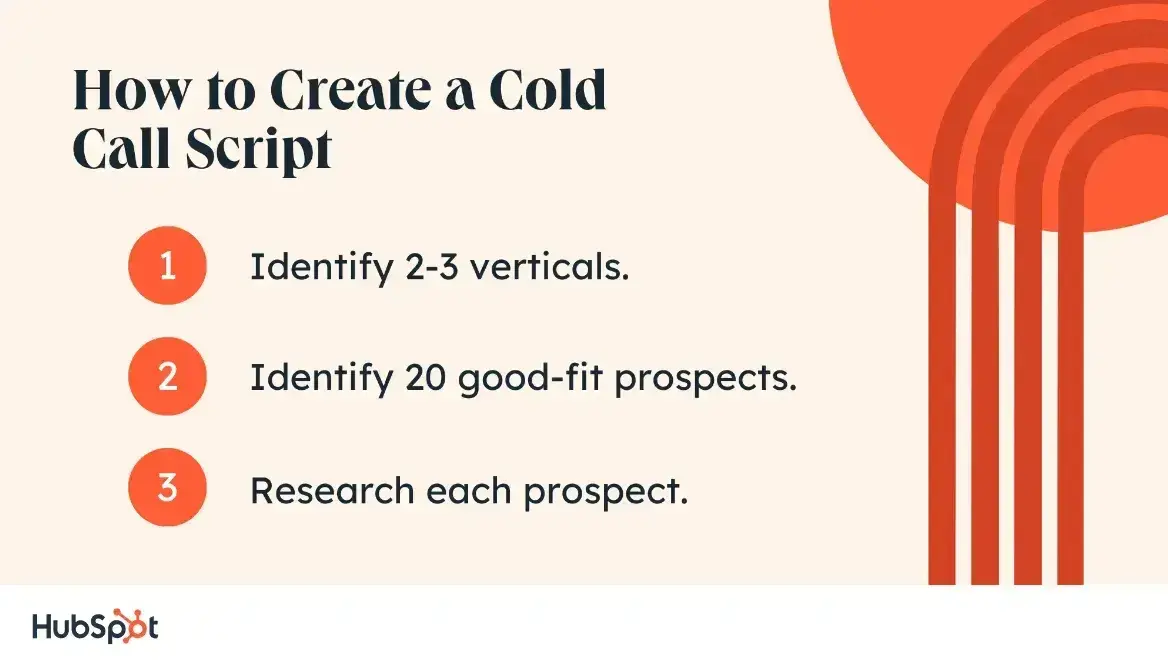
1. Identify 2-3 verticals.
First, you need to cherry-pick who you‘ll call. Your time is valuable — don’t waste it on prospects that aren‘t a good fit for your product. Think about who your best customers are (or who you’ve had the most success calling in the past) and look for common attributes.
Industry verticals are a good place to start. For example, maybe you deal exclusively with hospitality and retail companies. Or, your target markets could be finance and banking. Once you’ve figured out which verticals to target, you're ready for step 2.
Cold calling expert Alex Hobbs describes identifying verticals for outbound sales as “critical to revenue attainment today ... even inbounds need to be worked with an outbound motion! You can't just be an order taker/the fish are not jumping into the boat anymore!”
2. Identify 20 good-fit prospects.
I’ve found that it’s easier to find specific companies or people who could use your product or service using a tool like LinkedIn.
Let‘s say you’re looking for US-based hotel companies who might benefit from your on-site goat yoga classes (I mean, who doesn‘t want to do Shavasana with a baby goat while they’re on vacation?).
Search “General manager” with the “Hospitality” filter.
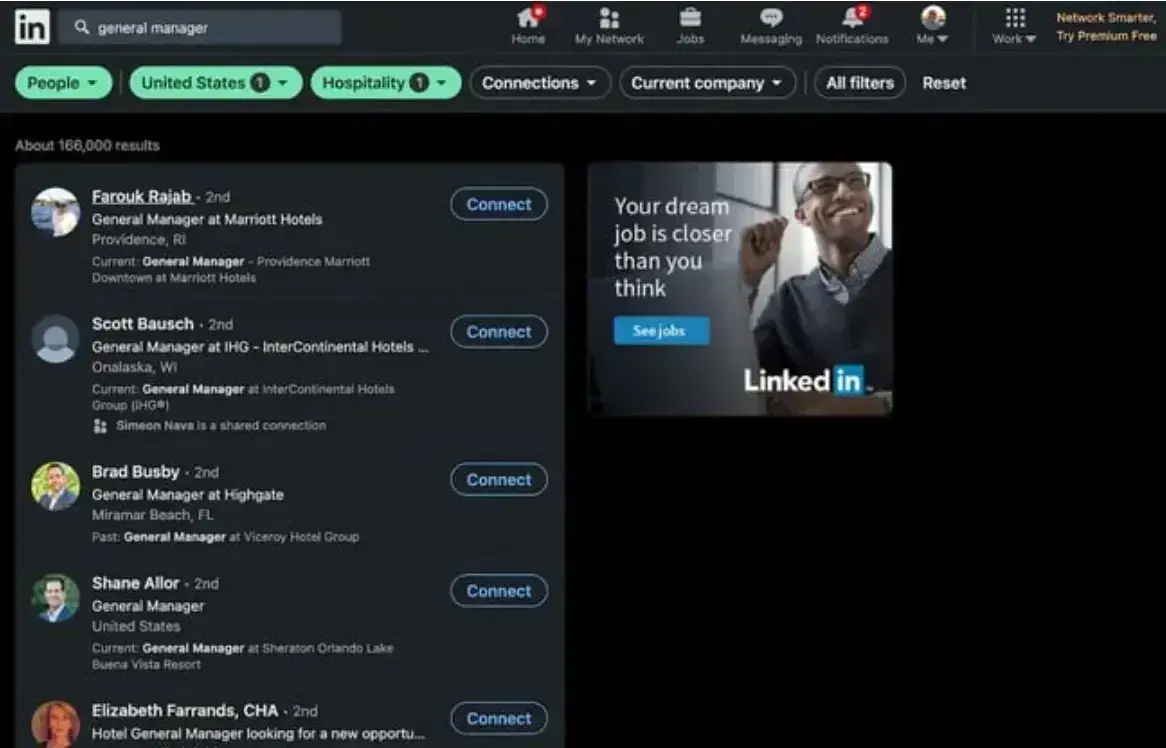
Voila — a list of potential customers.
I’ve also found that regional companies are a great start to your list, as people love to do business with other locals.
3. Research each prospect.
I know, I know, you'd rather just pick up the phone and call. But, spending just a few minutes on research can significantly increase your success rate.
Since you‘re already on LinkedIn, check out each prospect’s profile to personalize your approach. You'll want to know:
- What the company does.
- What the prospect does specifically.
- If you've helped a similar company in the past.
- One “fun fact” about them.
Here‘s one thing I never fail to do: Look up how to pronounce the prospect’s name.
Nothing makes people more annoyed and less likely to listen than hearing their name butchered by some fast-talking rep, so this step is crucial.
Some people add how they pronounce their name on Facebook and LinkedIn. If your prospect hasn't added this feature to their profile, try using PronounceNames to get an idea.
And if you‘re still out of luck? Be honest. When you start the call, say: “I want to be sure I’m saying your name correctly. How do you pronounce it?”
You should also follow their pronouns if they are listed in their LinkedIn bio. If you’re not familiar with how to use gender-neutral pronouns, here’s a great blog on the topic.
The Best Cold Calling Script Ever To Warm Up Leads
If you're having trouble coming up with a cold call script of your own, try this one. I’ve used this script before, and it works because it focuses on a simple introduction, rapport, and then a positioning statement. I also think it works because your research helps establish immediate value.
Sample Script
Hi [prospect's name], this is [your name] from [your company name].
I‘ve been doing some research on [prospect’s company name], and I‘d love to learn more about [challenge you’ve discovered in your research].
At [your company name], we work with people like you to help with [value proposition 1, value proposition 2, and value proposition 3.]
Is this something you think could help with [common challenges/pain points]?
Option 1: Yes, tell me more.
Great! [This is where you're going to ask them to attend a demo, or continue the conversation with an Account Executive, or take whatever next steps are part of your sales process.]
Option 2: Objection
I understand. Is it okay if I send you a follow-up email to review at your convenience? Then, I can follow up with you tomorrow.
If yes, send the email and set a reminder to follow up. If not, thank them for their time and ask if there's another point of contact they can connect you with. Make sure to include resources that clearly explain what your company does and ask to continue the conversation.
You may have noticed you‘re not really cold calling anymore, as you’ve already winnowed down your list and done some homework all before picking up the phone. I’ve found this extra work to be well worth it in securing customers.
Now, let's get to the script.
1. Introduce yourself.
First, state your name and the company you work for. You need to be clear, confident, and energetic. I can't tell you how many cold calls I listen to that begin with, "This is *mumbles* from ‘mumbled company name.’"
The confused prospect goes, “What? Who?” and you’re already off to a rough start.
You don't need to yell your greeting, but you do need to articulate the words.
After you say, “This is [name] from [company],” pause.
This is hard for cold callers. They want to jump straight into their pitch because they’re afraid of rejection. However, I caution you to take a deep breath and say nothing for eight whole seconds. Count it off, and it doesn’t seem like a long time. But trust me, during a cold call, it feels like an eternity. Hold the line, though, and it will be worth your while.
Why? Because when you pause, your prospect is searching their brain for who you could be. It sounds like you know them — are you a client? A former coworker? A current one?
2. Establish rapport.
Our call is already deviating from the standard cold call script, so why not ask them a question to establish some rapport? Your goal here is to get them talking and prove you're familiar with them and their company.
Here are some sample questions:
- I see you've been at [company] for [X years]. What do you enjoy about your role?
- Congrats on your recent promotion. How is your new position going?
- I’ve always been fascinated by the [enter industry they work in] industry. Can you tell me more about what your company does?
A good question is topical and makes someone smile. If they seem receptive to chatting, ask them a follow-up question. You don’t want to ask something too personal since this is likely the first time they’ve spoken to you, so stay away from information that’s not readily available on LinkedIn.
For instance, if they say, “I’m enjoying my new promotion; I’m able to get a lot more done,” you can respond, “That's great. How did you get started in this industry?” Maybe comment on a post they’ve recently made and how it made you think.
Eventually, they'll ask, “Alright, why are you calling?”
Acknowledge that their time is valuable and you have a pitch for them while still keeping the mood light. Be cordial and merry on the phone. This will change the energy from one of awkwardness to lightheartedness.
3. Use a positioning statement.
A positioning statement shows your prospect that you work with similar companies and understand their challenges. You're not talking about yourself, which is what most cold callers do. Keep the conversation focused on them and have a genuine discussion.
Here's a hypothetical positioning statement:
“I work with sales managers in hospitality with five to eight reps on their team. My customers are typically looking to increase rep productivity. Does that sound like you?”
Since you‘ve pre-qualified them, they’ll likely say “yes.”
Simply say, “Tell me more about that.”
Now, it‘s all about them! They’ll explain their pain points and objectives, which is valuable information you can use to build your sales pitch.
4. Thank them for their time.
Never end a cold call without letting your prospect know you’re grateful for the chance to speak with them.
Pranav Rawat, a cold calling professional, teaches this concept by stating that “no matter who your prospect is, their time is important. By saying thank you, you’re letting them know that you respect them, which is not only a good opening line but a great way to start a relationship, too.”
Cold Calling Script Variation
As a sales leader at HubSpot, I love assisting newer reps in closing big deals because I‘ve been in their shoes. It’s good for the company and the reps' careers. To do that, I use a slightly altered process and script.
We have a team culture of “just ask,” encouraging junior reps to request help from sales leaders when they want to set up meetings with CEOs or prospects at Fortune 500 companies.
Once a rep asks for my help, I ask for something in return: The website URL, the LinkedIn profile of the person and company I'm speaking with, and their HubSpot CRM record.
This allows me to quickly familiarize myself with the person and company I'm about to call. Once the phone rings and the prospect answers, I use the greeting from above, “This is [name] from [company],” then pause.
If you‘re calling a C-level executive or even a mid-level employee at a large organization, you likely had to get past an assistant or front desk, which is where your senior title helped. Gatekeepers are more likely to pass along “Dan Tyre, Director of Sales at HubSpot” than “[Name], a sales rep at HubSpot.”
They‘ll know who you are, but they’ll still be curious why you called. Keep them in suspense a bit longer. As in the script above, I'll spend a few minutes asking about them. Here are a few more questions I turn to:
- “Are you a cat or a dog person?”
- “Read any good books or blogs lately?”
- "What‘s your favorite restaurant in [Prospect’s city]? I’ve always wanted to visit.”
When the conversation turns to why I called, I say, “I called to help.” This line usually stops the prospect in their tracks.
Then, I follow up with, “My sales rep asked me to start a conversation with you.” This allows me to easily hand the conversation off to the rep if it goes well.
From there, I use a positioning statement like the one above:
“I work with sales managers in hospitality with five to eight reps on their team. My customers are typically looking to increase rep productivity. Does that sound like you?”
The pre-qualified prospect will answer “Yes,” and that's when my active listening turns on, and I say, “Tell me more about that.” Once they‘ve explained their pain points, I repeat what I’ve heard back to them: “So, what I'm hearing is …” and offer to set up a discovery call.
Usually, the prospect agrees and throws out a time for weeks or months in the future. I often reply with, “How about tomorrow?” Most of the time, prospects respond with, “Sure, what time?”
I‘ll then check the junior rep’s calendar and schedule the discovery call.
Cold Calling Script Templates
Ready to start cold calling? Here are some cold-calling script templates you can use to get started.
Featured Resource: 10 Sales Call Templates for Outreach.
This downloadable resource contains ten templates, including the examples listed below. I like that each script can be customized to fit your specific needs and scenarios. As stated previously, the more research you do on your prospect prior to calling, the better your results will be.
Discovery Sales Calls
Discovery is one of the trickier aspects of any sales process — it’s often as frustrating as it is necessary. You can‘t deliver on any other stage of your sales process if you don’t gather thorough, thoughtful context on your discovery call. Use this template to get the insight you need to support smooth, successful sales efforts.
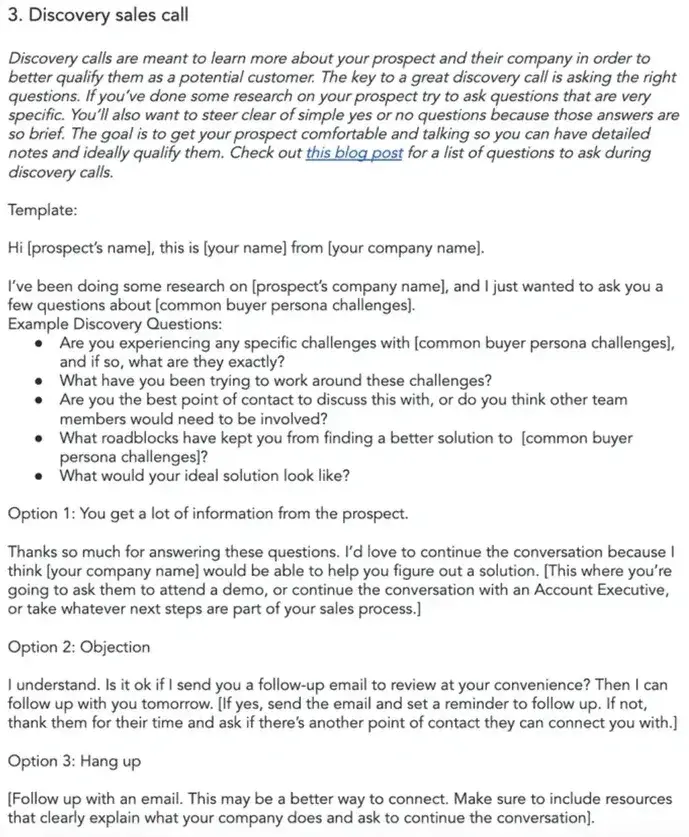
Gatekeepers
Learning how to handle interactions with gatekeepers is one of the trickier aspects of sales communication. You‘re bound to hit walls with administrative assistants, office managers, or other intermediaries between you and decision-makers at points in your career. Here’s the best script for working through those screening conversations.
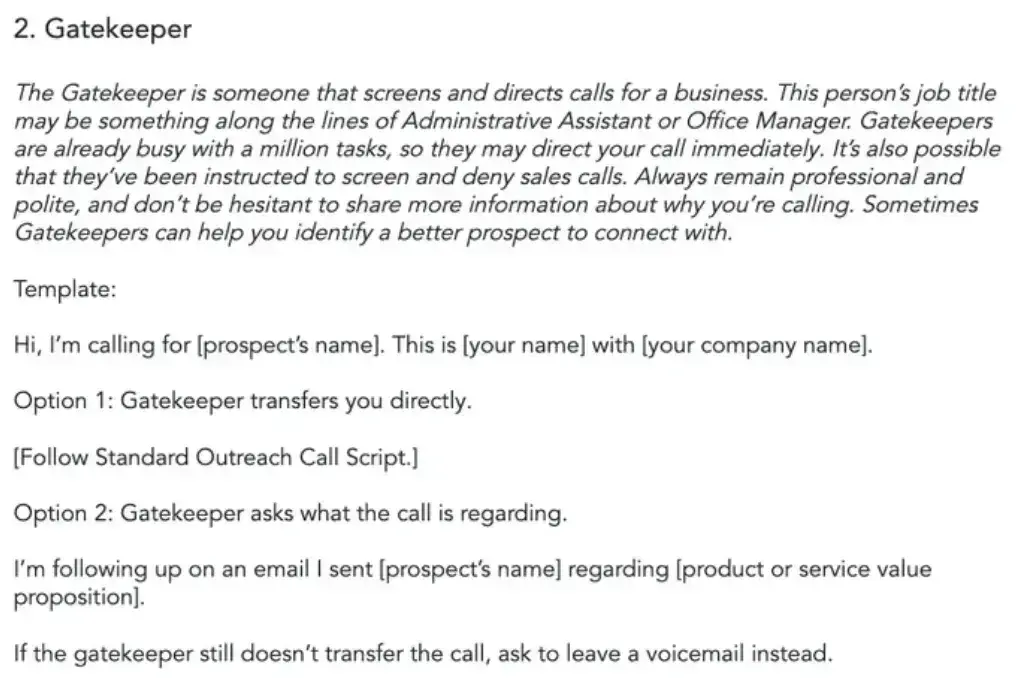
Mutual Colleague Recommendations
People trust their people — much more than they trust some random salesperson, at least. If you want to cultivate some quick social proof and approachability with prospects via an existing connection, consider leveraging a script like this. It shows you the most effective way to use a recommendation from a mutual colleague.
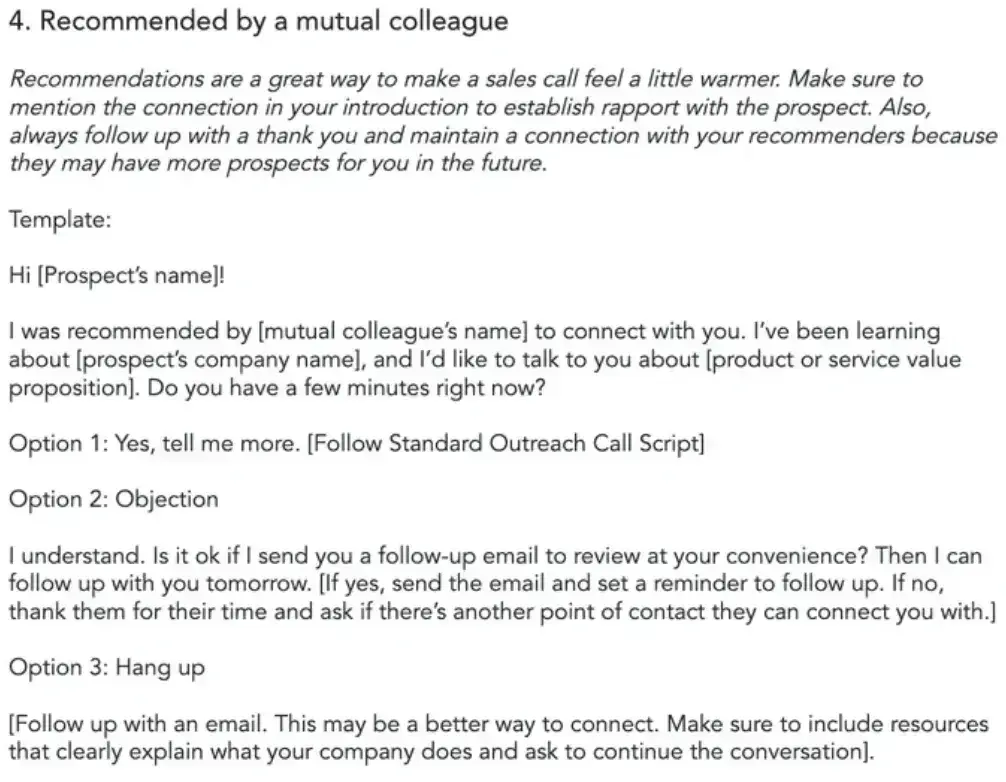
Follow-ups
So much of sales is powered by measured persistence. In many cases, you‘re not going to get the response you need (or a response at all) without following up. If you’ve already tried reaching out to a prospect, use this script to get a response.
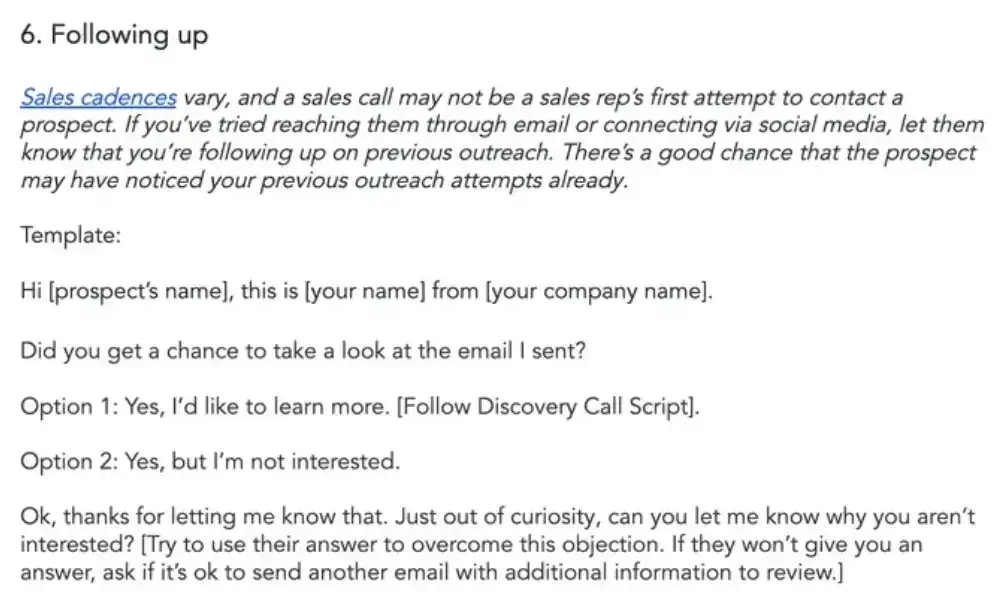
Connection Requests
Failing to connect with a prospect? This script provides an alternative route to reaching out.
25 Cold Calling Tips
- Be selective with prospects.
- Use the right tools.
- Practice your cold call script.
- Focus on them.
- Do your research.
- Find the best time to call.
- Pique curiosity.
- Be respectful of their time.
- Ask open-ended questions.
- Be an active listener.
- Pick out their pains.
- Anticipate objections.
- Use social proof.
- Focus on your goal.
- Have a ‘close’ in mind for every conversation.
- Make it easy to say yes.
- Follow up after the call.
- Leave a voicemail.
- Conduct call reviews.
- Spend more time selling.
- Make sure you offer value.
- Remember your why.
- Leverage AI for tailored cold calls.
- Assume familiarity for a warm tone.
- Lead with empathy.
Now that you have your script, here are some tips to keep in mind.
1. Be selective with prospects.
As a HubSpot employee, I try to live and breathe inbound marketing and sales, relying on my strong sales teams to close deals.
I know that a 100% inbound method might not work for your business — at least not overnight.
So, be selective with your prospects to mimic the success of inbound sales. That means you‘ll need to get creative with whom you add to your list.
If you can find hand-raisers (people already interested in the product or service your company provides), prioritize calling them first. If they’re interested in what you have to offer before you call, you'll be well on your way to closing them on the solution you sell. And that brings me to my next point.
2. Use the right tools.
Although a solid script and an excellent sales team will yield good results, remember that they can only take you so far.
As I just mentioned, you need to pick and choose between prospects so sales reps or cold calling services won’t waste time reaching out to people who don’t show much interest in your business. That requires data — lots of it.
Most dedicated sales tools help you reach the right prospects by providing you with the tools necessary to score and qualify leads as well as track prospects as they move through the sales funnel.
Other tools bring more to the table. For example, HubSpot’s sales software can record and transcribe cold calls, so you can later leave feedback to sales reps via its Conversation Intelligence feature.
Or, if you want to ensure your reps nail cold calls on the first try, set up interactive playbooks. You can store use-case-specific call scripts, training materials, and more to give sales agents the ability to adapt and get the guidance needed mid-call.
Meanwhile, scheduling meetings is just a matter of letting prospects pick a time and date that works best for them. You can also send quotes and collect payments directly within HubSpot, so you don’t have to always jump from one software solution to the other.
3. Practice your cold call script.
While you don‘t want to sound robotic and rehearsed, you do want to repeat your script so you don’t forget it.
The better you know the goals of the script, you‘ll be able to think on your feet if the prospect comes back with a comment or question you hadn’t planned for.
With each call, you‘ll get a chance to practice your cold calling script — and you’ll learn strategies to make future cold calls more effective.
4. Focus on them.
When I craft a cold-calling script, I find it’s easy to fall into the me-me-me trap:
- “We at [Company] offer...”
- “We're the best at...”
- “I want to schedule a meeting to...”
Instead, you should be putting your focus on the prospect using “you” language:
- "Are you experiencing challenges with..."
- "What roadblocks kept you..."
- "Would you benefit from..."
Doing so centers them in the conversation, making it personalized and relevant.
5. Do your research.
Before you pick up the phone, make sure you have plenty of information about your prospect.
I try to learn what the company does, find the prospect's role at the company, and discover whether I’ve worked with their company or a similar company in the past.
Other publicly available information is also useful: Where did they go to school? Do you know a friend or colleague? Did they recently attend an industry event? These are some rapport-building topics you can use to start the conversation.
6. Find the best time to call.
Although there isn't a universal “best” time to make a cold call, some experts recommend early mornings or late afternoons since individuals haven't yet started their day or are already wrapping it up — thus increasing your chances of getting through.
However, the more cold calls you make, the more you'll get a feel for the days and times that have the most success. Once you do, prioritize your calls and make the most important ones during those windows.
7. Pique curiosity.
I try to open the conversation by generating intrigue and interest. If you can get prospects invested in the conversation, you'll give them a reason to keep listening.
The Harvard Business Review notes that “curiosity is a powerful practice to infuse into a company’s culture.” It can reduce stress, as curious individuals are seen as more communal and friendly. So, curiosity is a key component of effective cold-calling. Curious prospects might give you more of their time to explore solutions to their problems.
8. Be respectful of their time.
While it's essential to establish rapport and start the conversation off on a positive note, be mindful that cold-calling is somewhat intrusive. You have interrupted their day, so get to the point quickly.
Use your positioning statement early on in the call or make a transition like this one: “The reason I'm calling is to … ”
These will signal to the prospect that you'll be quick and to the point.
9. Ask open-ended questions.
I avoid asking “yes or no” questions. Instead, I ask open-ended questions that will keep the conversation going, especially when asking the prospect about their pain points and goals.
You could say:
Hi [prospect's name], this is [your name] from [your company name].
I‘ve been doing some research on [prospect’s company name], and I just wanted to ask you a few questions about [insert chosen topic].
What roadblocks have kept you from finding a better solution to [insert chosen topic challenges]?
(They answer)
I'd love to continue the conversation because I think [your company name] would be able to help you figure out a solution. [Then take whatever next steps are part of your sales process.]
Asking open-ended questions helps you get more information and helps you create a tailored solution to their specific challenges.
10. Be an active listener.
It can be easy to get lost in the conversation, but ensure you‘re listening carefully to the prospect’s responses.
When appropriate, repeat what they said about their company or goals. This helps you clarify what they said and shows the prospect that you truly care about what they're saying.
11. Pick out their pains.
I often find that eliminating pain points is a more powerful approach to incentivizing prospects than adding value. As you get the prospect to open up about their organization, role, and situation, listen for current struggles, points of contention, or problems they may be experiencing.
This may give you an “I can help with that” moment with the prospect.
You can build off of the open-ended questions script:
Hi [prospect's name], this is [your name] from [your company name].
We‘re a [type of company] platform that helps companies like yours [the problem you solve]. I’m calling to see if we can provide assistance.
What roadblocks have kept you from finding a better solution to [insert chosen topic challenges]?
(They answer)
I can totally understand your frustration with that. It sounds like your team is having trouble with [summarize their pain points/issue]. We work with a few companies like yours, and most have found our services to be [how your product/service helped]. Do you have something similar in place?
This script helps you nail down their challenges and presents your services as a remedy.
12. Anticipate objections.
The more calls you complete, the more you‘ll get a feel for the types of objections you’ll get.
For example, the prospect may already be working with a competitor. You could respond with:
“Yes, I am familiar with them. Why did you choose [company name]? What‘s working? What’s not? Allow me to explain how [your product/service] is different.”
In some cases, they will have no intention of changing providers, so there’s no reason to continue the call.
But for the cases where it is a good opportunity to press on, having a scripted response to handle the objection will keep you from getting caught off guard and allowing the call to come to a grinding halt.
13. Use social proof.
Once I’ve discovered that my prospect is an ideal client, I guide the conversation to what I have to offer them. But I don’t expect them to take my word for it; I will:
- Tell stories about customers with similar business structures as them, illustrating what I was able to do for those customers.
- Use case studies that show what they stand to gain.
- Show testimonials and success stories.
14. Focus on your goal.
Cold calls have two goals: Introducing yourself to the prospect and setting up a discovery call with them. Remind yourself of the desired results to help you stay on track as you're cold-calling prospects.
15. Have a ‘close’ in mind for every conversation.
Sales Pro Jeff Hoffman recommends always having a small close in mind for every point of contact you have with a prospect. For a cold call, that small close might be getting five more minutes of a prospect's time or setting up a follow-up call for later in the week.
Before each email you send and phone call you make, identify the close you'll use to encourage more streamlined and focused communication.
16. Make it easy to say yes.
Regardless of which ‘close’ you end up choosing, focus on selling just that ‘close.’ The more complicated you make it for the prospect, the easier it is for them to say ‘no.’
For example, if the big goal is to sell a turn-key software package in the four figures, but you know that your demo will blow them out of the water, just sell the demo.
Make it easy for them to commit to the demo with no strings attached, and make it easy for them to schedule and show up to the demo. Don't fuss with the details about software packages in this initial step when you can deal with those details later (presumably after the demo). Doing so will plant objections in their mind before you get your foot in the door.
If I know that a prospect won’t commit to a demo, I assume they need more time in the purchase funnel, which means they need more useful content. I send them articles, blogs, handouts, white papers, etc., that will make their life easier and help them excel in their industry. Remember, “Value is not what you say it is; it is always what the buyer perceives it to be” (Art Sobczak).
17. Follow up after the call.
If my prospect isn't available to meet again until the next week or so, I will follow up with them within a day after our initial cold call. I try to go beyond the traditional “thanks for your time” and offer some valuable information that could help them in the period between our last conversation and their decision about my product.
You could try something like:
Hi [prospect's name], this is [your name] from [your company name].
Did you get a chance to take a look at the materials I sent over?
If they say yes, follow up with some discovery questions or the next step in your sales process.
If they say they're not interested, you could end with:
Thanks for letting me know. Just out of curiosity, could you tell me why you aren't interested? [Try to use their answer to overcome this objection].
18. Leave a voicemail.
In today‘s digital world, voicemails seem like an old-fashioned method of communicating with your prospects, but they’re a smart way to keep yourself top-of-mind with them when they check their messages. When your prospects have overflowing email inboxes daily, stand out with a voicemail.
Hi, this is [your name] from [company name].
I'd like to learn more about [chosen topic] to see if [your company name] can offer a solution.
You can reach me at [your number]. I'll also follow up with an email [specified date/time]. I look forward to speaking with you.
Have a great day.
You can even adjust your cold calling script to work with voicemail. Remember to address the prospect by name, introduce yourself, your company, and the need you‘re planning to address with them. Don’t sell in the voicemail; provide just enough information to pique their interest.
19. Conduct call reviews.
Don’t let your cold call script or etiquette get stale. As my product or service evolves, so should cold call techniques.
Conduct a call or “film” review with your sales team on a monthly or quarterly basis. Select a few recorded (with permission) calls, sit in on a few live attempts, and have reps provide constructive feedback on what went well and what could be improved for the next time.
20. Spend more time selling.
I’ve found that sales automation software is a sales rep‘s best friend. Little tasks like scheduling meetings, leaving voicemails, and sending follow-up emails might only take a few seconds to do, but when you multiply that by your daily quota, you’ll see hours per week spent on administrative tasks.
Automate these responsibilities with software and cold calling tools that can do the work for you. These platforms streamline manual tasks so you can spend more time doing something technology can't — researching your prospects, building rapport, and closing deals.
21. Make sure you offer value.
I often ask myself after a call what value I offered my prospect. If I’m not answering their questions and solving their pain points, I’m wasting both their time and mine. If I don’t think I’ve established enough value, I send them more content to help them learn what my product/business has to offer them. Never underestimate the importance of educating your prospect with free, valuable content.
In his book Cold Calling Techniques, Stephan Schiffman says, “Success comes from helping people do what they want to do, not what you want to do.” Make sure your priority is helping your prospects accomplish the things they want to accomplish at their organization.
22. Remember your why.
Cold calling can get repetitive and robotic pretty fast. Dialing, reciting your script, asking for the next call, and doing it all over again can start to wear on your enthusiasm, but don‘t let it. When you’re struggling to make it through those last few calls of the week, remember why you love to do what you do.
Whether you keep your family‘s picture on your desk, an inspiring note from a colleague, or an encouraging quote from a leader, always keep your “why” in mind. On those amazing days when you’re closing left and right and those slower days when you can't quite get into your groove, your “why” will keep you motivated.
Famous saleswoman Mary Kay Ash said, “Pretend that every single person you meet has a sign around his or her neck that says, ‘Make me feel important.’ Not only will you succeed in sales, you will succeed in life.”
23. Leverage AI for tailored cold calls.
David Breitenbach, Chief Marketing Officer at PatentRenewal.com, says, "One of the top tips for successfully conducting cold calls is to leverage AI tools for in-depth prospect research. AI can provide insights into a prospect's recent activities, interests, and industry trends, allowing you to tailor your approach more precisely. For example, knowing a prospect recently expanded their business can help you position your product as a tool to support their growth.
"Additionally, personalize your opening statement by referencing a specific piece of information you discovered through your research, which can immediately capture their attention. Another innovative approach is to use AI to predict and preempt objections. By understanding common concerns within the prospect‘s industry, you can proactively address potential objections, showcasing your product’s value more effectively.
“By combining AI-powered insights with personalized and strategic communication, you can transform your cold-calling process and achieve higher success rates.”
24. Assume familiarity for a warm tone.
Tanya Slyvkin, Founder and CEO of WhitePage, says, "Pick up the phone and assume you are talking to your favorite cousin who just showed up on Christmas. You will have the perfect tone, as you won't sound robotic or salesy. The conversation will be casual, enthusiastic, respectful, and somewhat familiar.
“It will have the client disarmed and keep them engaged long enough to create trust due to the familial pitch. They are more likely to hear you out and respond positively. Like everyone, it is okay to have a fear of rejection when cold-calling, and if a few calls don't work out, remember they are not rejecting you. They are simply rejecting what you are proposing.”
25. Lead with empathy.
Tristan Harris, Demand Generation Senior Marketing Manager at Thrive Digital Marketing Agency, says, "Empathy is crucial. Remember, you're talking to another human being who likely receives numerous unsolicited calls. Start with a friendly greeting and acknowledge their busy schedule. Being genuine and transparent about the purpose of your call can build trust.
“Ask open-ended questions to engage them in a dialogue rather than delivering a monologue. Listen actively to their responses, and adjust your approach based on their feedback. By focusing on building a relationship rather than just making a sale, you‘re more likely to leave a positive impression and lay the groundwork for future opportunities, even if the initial call doesn’t result in an immediate conversion.”
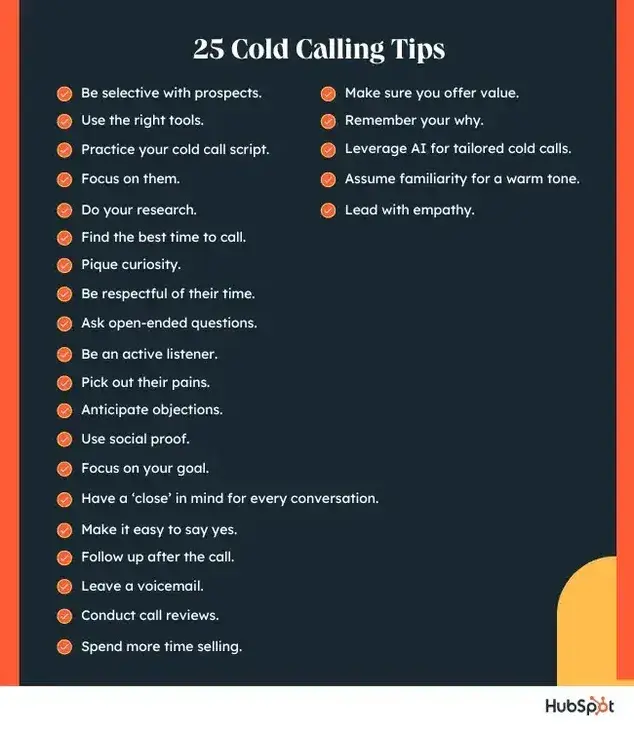
7 Techniques to Master Cold Calls
For many sales reps, even the words “cold call” are nerve-wracking. We all know what it’s like being at the customer end of a (not-so-great) cold call. Sales teams are often met with apathy, irritation, or outright hostility.
Despite these challenges, cold calls remain effective. So, how do you master the art of cold calling? Part of the answer lies in the scripts and tips listed above. By following tried-and-true methods, you can increase your chances of success and reduce the risk of outright rejection.
It’s also critical to train yourself in techniques that help improve your cold calling capabilities. Here are seven ways to boost your cold calling confidence.
1. Focus on problem-solving.
It’s easy to get caught up in the fact that you’re selling a product or service. This casts you in the role of the pushy salesperson and your prospect in the part of an unwilling call recipient. It naturally creates an oppositional dynamic that undermines your goal: Creating connection.
Instead, focus on problem-solving. You’re not trying to sell someone something they don’t need. You’re trying to help them solve a problem — one they might not even know they have — by creating a win-win scenario.
2. Know your product or service inside-out.
A little knowledge goes a long way. The more you know about your product or service, the better — in-depth information offers a soft landing place if you feel your confidence starts to waver. If you know your product inside-out and backward and forward, you’re never at a loss for words because you’re ready to answer any question and address any concern.
3. Expect the unexpected.
No matter how much prep work you do, calls never go as planned. You might have all your ducks in a row — you’ve got a solid prospect lined up, your company has just released a new product version, and you got a great night’s sleep — but five minutes into the call, your prospect is pulled into a meeting.
Two hours later, you call back only to discover that customer plans have changed, and the script you’ve spent so much time preparing no longer applies. The trick? Don’t get locked into a single format or sequence. Scripts act as a starting point, but you’re the one who makes the sale.
4. Create the right environment.
The right environment can help reduce your stress around cold calling. For some people, the ideal environment is a busy office. The presence of other sales staff boosts their energy and gives them increased confidence to tackle cold calling lists.
For others, a quiet space is the best option. This might be your desk at home or an office with a closed door at work. It might involve soothing music in the background or softer lighting to help you relax.
Bottom line? Do whatever works for you to maximize your comfort when cold calling.
5. Don’t take it personally.
Not everyone will be nice. It’s true in life, and it’s true in cold calling. While the potential for unpleasant interactions is higher for cold calls than everyday conversations, you never know how prospects will respond until you get them on the line.
In many cases, a negative reaction has nothing to do with you. Prospects may have had a tough morning or a rough week, or may simply be predisposed to dislike cold calls. No matter what happens, however, the outcome is the same: When the conversation is over, you’ll hang up the phone and go on with your day. Even if your last call was a total disaster, you’ll never hear from that prospect again — so don't take it personally.
6. Recognize that “no” is better than nothing.
If you get a “no” it means you’re doing your job. No ends the conversation and lets you move on to the next prospect, satisfied that you’ve done everything you can to make the sale. This provides a closure.
Consider a prospect you simply can’t reach. Because you don’t have a “no” — or a “yes” — you have to keep calling. Getting turned down frees you up to focus on your next task.
7. Dive right in.
No matter what techniques you use to boost your confidence, there’s only one sure-fire way to get better at cold calling and reduce your anxiety: Diving right in, and making the call.
The more calls you make, the more you’ll learn. You’ll discover what works, what doesn’t, and where you can improve. You’ll pinpoint nuances in different prospect types that help you tailor your sales pitch, and you’ll get more confident in picking the right type of cold calling script.
Sure, the water’s cold, but diving right in is the best way to get over the shock.
Cold Call Script Templates That Work
This script and these tips will help you be a more effective cold caller. Just remember that it‘s all about providing value. By piquing a customer’s curiosity and solving their needs, you’ll build rapport and win prospects over, even if the conversation begins “cold.”
The work doesn‘t stop here. You’ll need to tailor your new script and template to fit your business, prospects, and personal style. Once you do, you'll see a much higher return for your efforts.
Editor's note: This post was originally published in September 2017 and has been updated for comprehensiveness.



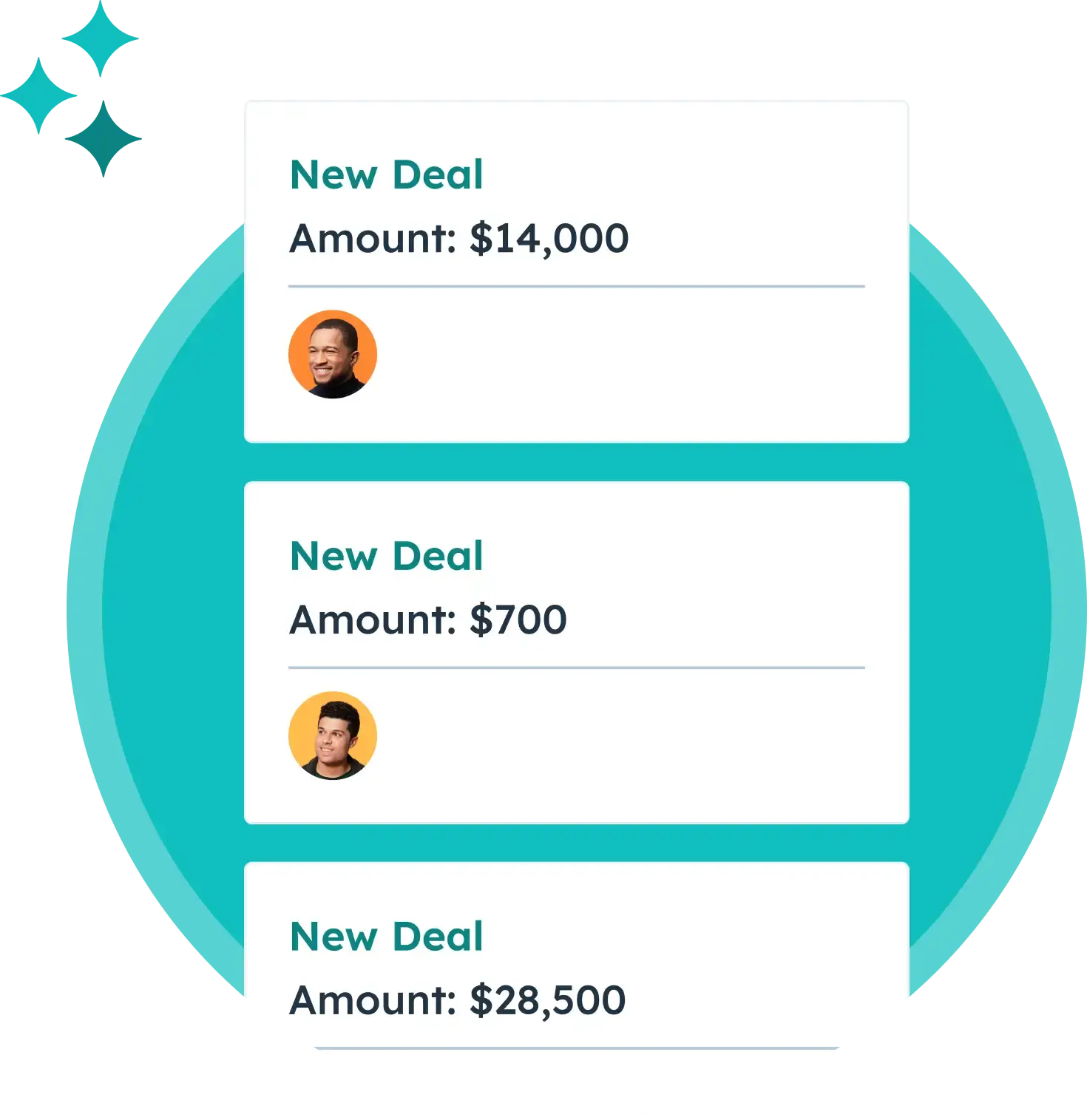




![4 Key Cold Calling Mistakes to Avoid [& How to Fix Them]](https://53.fs1.hubspotusercontent-na1.net/hubfs/53/Cold%20calling%20mistakes%20(1).jpg)

![The Best Time to Cold Call & More Data-Driven Sales Secrets [Infographic]](https://53.fs1.hubspotusercontent-na1.net/hubfs/53/treasure_chest.webp)